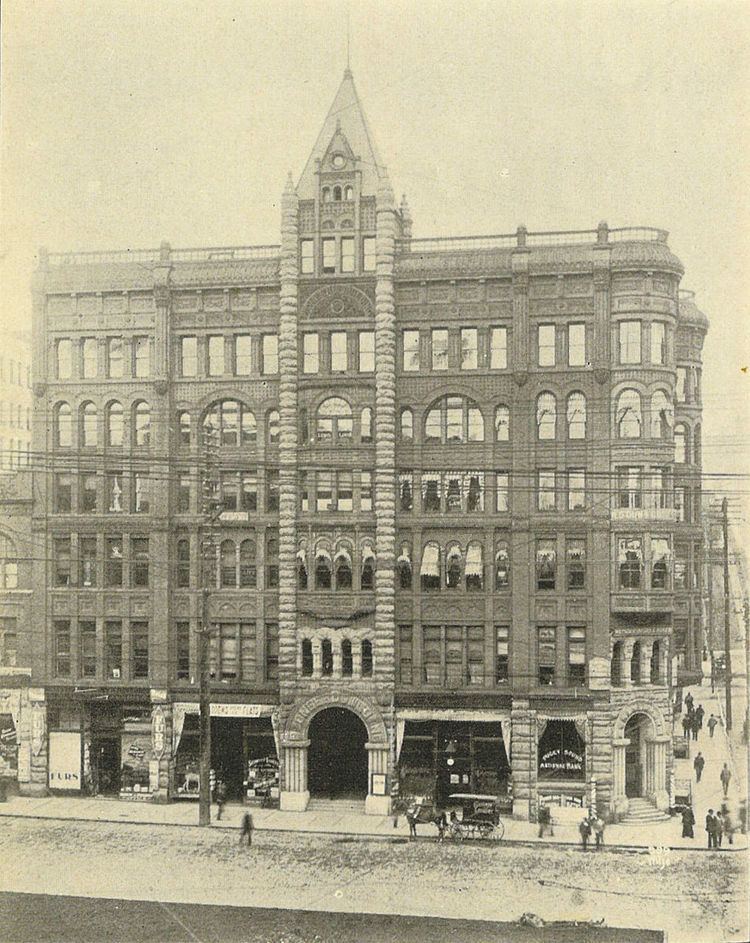Surpassed by Alaska Building Construction started 1889 Cost US$250,000 Phone +1 206-624-1783 | Type Commercial offices Completed 1892 Height 28 m Architect Elmer H. Fisher | |
 | ||
Hours Open today · 9AM–5PMMonday9AM–5PMTuesday9AM–5PMWednesday9AM–5PMThursday9AM–5PMFriday9AM–5PMSaturdayClosedSundayClosed Similar Smith Tower, Alaska Building, Hoge Building, Sinking Ship, Safeco Plaza | ||
The Pioneer Building is a Richardsonian Romanesque stone, red brick, terra cotta and cast iron building located on the northeast corner of First Avenue and James Street, mere yards from where James Street runs into Yesler Way, in Seattle's Pioneer Square District. Completed in 1892, the Pioneer Building was designed by architect Elmer Fisher, who designed several of the historic district's new buildings following the Great Seattle Fire of 1889.
Contents
Location
From Seattle's earliest days until the early 1880s, the corner of First and James was the site of Henry Yesler's home, with his steam-powered sawmill located across the way. Yesler moved to his new mansion, designed by architect William E. Boone, three blocks away at 4th and James in 1884. He began planning an office block at First and James in early 1889. Several months after the Great Seattle Fire leveled 32 blocks of downtown, Yesler proceeded with the construction of the Pioneer Building.
Design
The Pioneer Building is a 94-foot-tall (29 m) symmetrical block, measuring 115 by 111 ft (35 by 34 m). The exterior walls are constructed of Bellingham Bay gray sandstone at the basement and first floor, with red brick on the upper five floors (with the exception of two stone pilasters which extended to the full height of the tower over the main entrance). Spandrel panels and other ornamental elements are terra cotta from Gladding, McBean in California. There are three projecting bays of cast iron, the curved bays at the corner and on the James Street facade, and the angled bay above the main entrance.
The building reflects a mix of Victorian and Romanesque Revival influences. The facades, with vertical pilasters and horizontal belt courses creating a grid, reflect Victorian compositional strategies. Details such as the round arches over groups of windows and the arched main entrance and corner entrance are Romanesque Revival elements.
The exterior walls are load-bearing, as is the firewall that extends through the building from the street to the alley. The interior structure is cast iron columns and steel beams supporting timber joists. As was typical practice in the period, the office floors were designed and built with permanent partitions forming 185 office rooms—a tenant would simply rent one or more office rooms. Light is provided to the interior through two atria—one in the center of the south portion of the building, the other in the north portion of the building.
Constructed at a cost of over $250,000, the Pioneer Building was considered one of Seattle's finest post-fire business blocks. It has always been highly visible, forming a portion of one side of Seattle's Pioneer Place Park.
The Pioneer Building originally had a seventh floor tower room (with a pyramidal roof) located directly above the front entrance making the building 110 ft (34 m). It was removed as a result of damage caused by the 1949 earthquake.
History
The newly constructed building quickly became an important business location for downtown Seattle. During the Klondike Gold Rush, in 1897, there were 48 different mining companies that had offices there. Later on, during Prohibition, the Pioneer Building was the clandestine location of "Seattle's First Speakeasy."
The downtown area began to grow northward, prompting businesses to move in the same direction. By the 1950s and '60s, the entire Pioneer Square district had fallen upon hard times. Many of the buildings, which were barely 60 years old, sat empty and decaying, and were slated to be torn down and replaced with parking garages. The Seattle Hotel was the first to be razed, which prompted the citizens to initiate a campaign to preserve the district. The rest of the buildings were spared the wrecking ball, and Pioneer Square-Skid Road Historic District were listed on the National Register of Historic Places. In 1977, the Pioneer Building was listed as a National Historic Landmark.
Today, the Pioneer Building houses, among other things, Doc Maynard's Nightclub and Lounge, where one can buy tickets for the popular Seattle Underground Tour. At the end of the tour, there is a gift shop, located fittingly in the building's ground-floor level.
Several businesses and offices are also located inside, including The Olmsted Law Group PLLC, dePonce Immigration and Citizenship Law, Cost of Wisconsin miniature golf-course designers' Western Regional Office, and Henry's Bail Bonds.
Current Use
In December 2015, the Pioneer Building was purchased by workspace provider Level Office, which plans to renovate the building's interior to create private offices and co-working space for small businesses.
